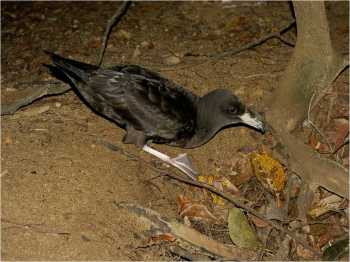Sarah Jamieson and Susan Waugh (Museum of New Zealand Te Papa Tongarewa, Wellington, New Zealand) have published in the journal Notornis on the status of the Flesh-footed Shearwater Puffinus carnepeis at three New Zealand breeding localities.
Flesh-footed shearwaters (Puffinus carneipes) are considered to be one of New Zealand’s seabird species that is most heavily impacted by both commercial and recreational fisheries, yet they have an IUCN ranking of “Least Concern”. To resolve this contradiction we conducted surveys on 3 large breeding colonies and compared our results to historical data. We found that the burrow density on the most northerly island (Lady Alice Island/Mauimua) has increased since the last set of surveys; however the density of flesh-footed shearwaters nests has remained stable. At the largest colony we surveyed (Ohinau Island), the density of burrows has remained stable, while the density of nests has declined. At New Zealand’s most southerly colony (Titi Island), both burrow and nest densities have remained stable. Our results suggest that the status of flesh-footed shearwaters populations in New Zealand is variable with 2 populations that are stable and 1 that is declining. Nevertheless, due to the short time period between our surveys and the historical data, repeated surveys in the future are needed to determine if further declines in the largest colony warrant a reassessment of the status of this species.

Flesh-footed Shearwater, photograph by Barry Baker
Reference:
Jamieson, S.E. & Waugh, S.M. 2015. An assessment of recent population trends of flesh-footed shearwaters (Puffinus carneipes) breeding in New Zealand. Notornis 62: 8-13.
John Cooper, ACAP Information Officer, 24 April 2015

 English
English  Français
Français  Español
Español